Motorcycle printer's mark on shipped letter
It will be known to most members that I, Nico Helling, regularly participate in exhibitions with my collection "The Motorcycle, its history and the different modes of use". Started in category 3 and slowly moved up to International. Compare it with road racing: from Moto3 via Moto2 to MotoGP and Inters. More and more is demanded from the collection. Not only more sheets, from 36 (3 frames) to 96 (8 frames), but also more diverse material. Diverse in time, place, and type. So not only modern material but also older, material from all over the world and last but certainly not least not only stamps but also booklets, cancels, postage, postal items, postal stationery and sheet edges. In addition to print marks, these sheet edges can also contain thematic images. One of those images is the printer's mark "motorcycle".
On the Dutch sheets we find a so-called printer's mark above stamp 10 between 1920 and 1925(?). From that mark it could be deduced which printer was responsible for a certain sheet (for checking). Initially, 50 different images were issued.
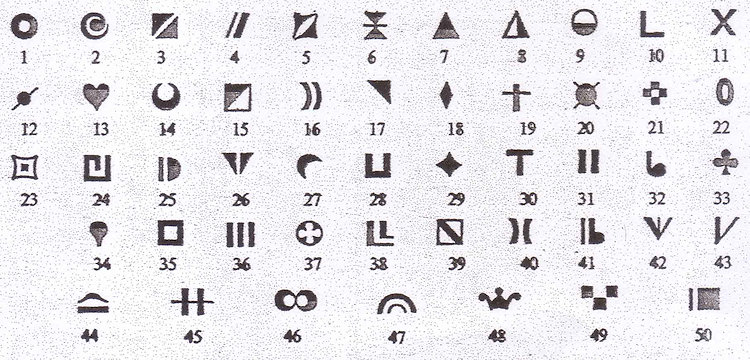
In 1922 50 more images were added.
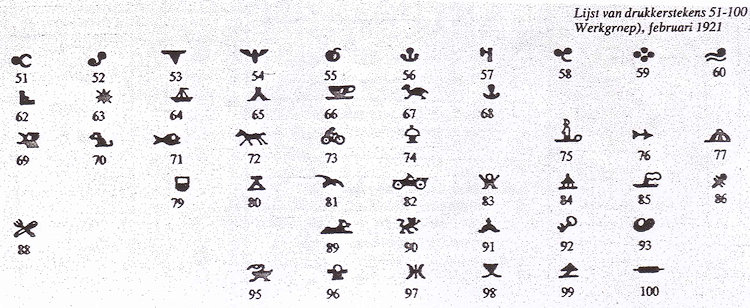
Multi-colour stamps have multiple printer's marks. As can be seen in both lists, the marks are figurative or abstract. Apparently the motorcycle was already so popular in 1922 that a (simplified) image was added to the list. In the list of marks we see the simplified motorcycle at number 73.
Because the mark only occurs once per sheet (thus at 1 of 100 or 200 stamps) they are rare. On the block below we see an example of printer's mark number 73, on airmail stamp number 1 (NVPH - Dutch Stamp Traders Association) of the Dutch East Indies.
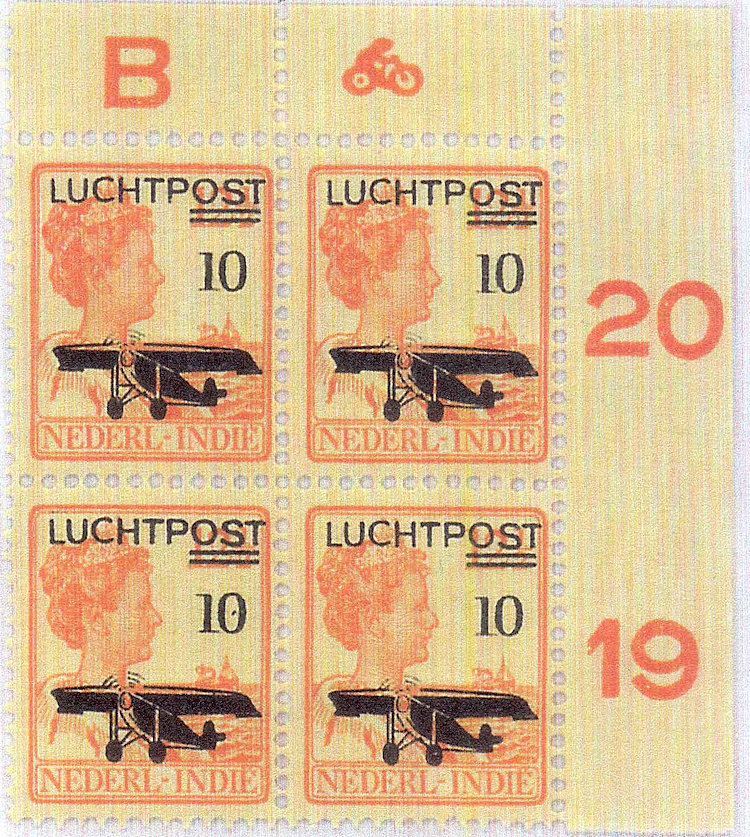
Also the Dutch stamp number 111 (NVPH) has been printed by the same printer:

In addition to collectors of sheet-edge details, some stamps with printer's marks are also sought after by thematic collectors like me. For more information about the stamps with this printer's mark, see the article by Hans de Kloet in Newsletter 100 (June 2012) entitled "New views on old information".
For years I have shown stamp number 111 in my collection at the sports section, with the explanation that there was little difference between motorcycles used for races on paved (road race) and unpaved (cross) surfaces.

A few times, however, I was advised by jury members to show one of the Dutch East Indies in addition to the Dutch stamp. This would show philatelic knowledge.
The price of the Dutch East Indies stamps with motorcycle printer's marks has been the reason I didn't do this for a long time. Until I saw a few months ago an offer for a letter from the Dutch East Indies to the Netherlands, with the popular printer's mark!
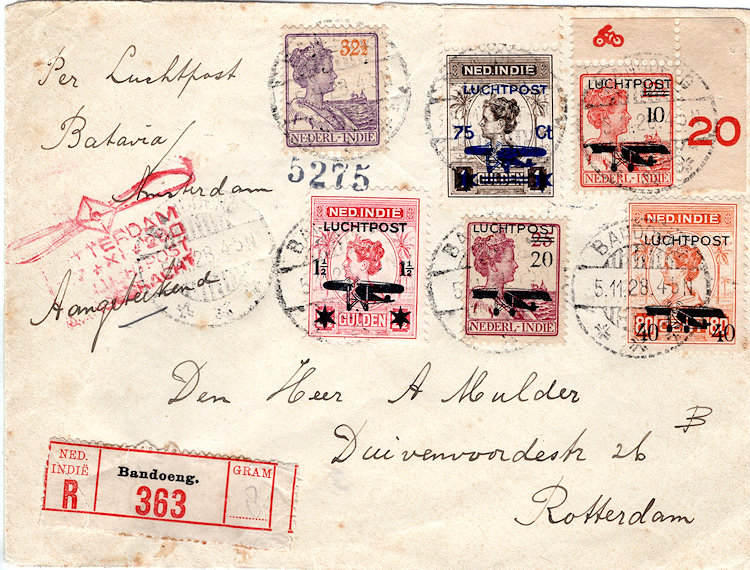
Although it cost quite a lot of money I purchased it. In order to use the letter in the exhibition the rate must be explained. The Geuzendam catalog states:
- p. 337: postage abroad from 01-10-1926 to14-06-1937: 12½ cents
- p. 338: registered from 01-05-1921 to 01-10-1947: 20 cents
- p. 339: Airmail Netherlands from 01-11-1928 to 01-07-1930: 75 cents
The stamp at the top left of 32½ cents is sufficient for postage and registration fees. But the airmail stamps are much more than the required 75 cents, namely 2 guilders and 95 cents.
Thus I started searching the internet to explain the difference in airmail rate. After a long search I came across an article by Cees Janssen, posted on:
www.postzegelblog.nl/2015/08/13/de-eerste-luchtpostzegels-van-nederlandsch-indie
In this (Dutch) article, in translation published below in its entirety with the permission of the author, came my startling statement. Read for yourself and shudder.
The first airmail stamps of the Dutch East Indies
The transport of letters and postcards by air came into use more and more from 1927 on. Because of this it became necessary to establish air duties for the transport of postal items, in order to stimulate postal transport by air. This happened all over the world and fixed rates for air duties were also announced in the Dutch East Indies.
On September 20th 1928 a series of five stamps was issued with overprint as provisional airmail stamps, while a final series was being prepared. The Indies Postal Service had provided the post offices with the following values for the fulfillment of air duties for the various types of postal items.
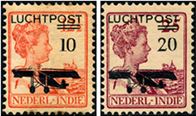
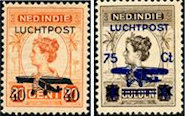

For domestic flights, i.e. within the area of the Dutch East Indies, the following rates and duties applied:
- Postcard: 7½ cents with air duty 10 cents.
- Letter up to 20 grams: 12½ cents with air duty 20 cents
The following rates and duties applied to flights to the Netherlands:
- Postcard: 7½ cents with air duty 40 cents
- Letter up to 20 grams: 12½ cents with air duty 75 cents
- Letter heavier than 20 grams to 40 grams: 20 cents with air duty 1½ guilders.
For registered mail, the duty of 20 cents was charged, which could only be paid with the normal postage stamps.
Registered letters franked with a complete series of airmail stamps are quite common. Usually these letters can be recognized as such as "artificial work" and are intended for collecting purposes. Like the letter shown below that weighed 12 grams.
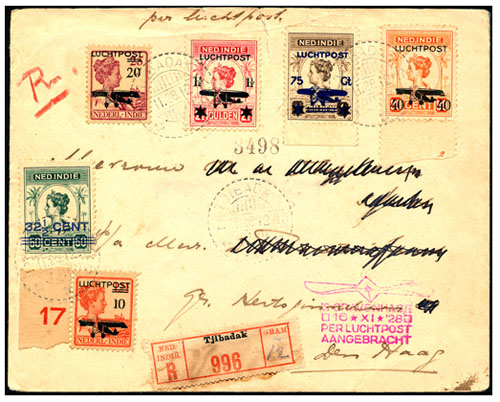
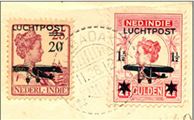

 The letter was sent from Tjibadak on November 2nd 1928 to The Hague. The postage and registration fee, 12½ cents plus 20 cents, was paid with the 32½ cent postage stamp. The 75 cent airmail stamp would have been sufficient, but the sender opted for a complete set. The letter was sent along with the so-called first return flight that departed on November 6th 1928 from Bandoeng to Batavia, and from there on November 7th 1928 to Amsterdam. The letter was sent from Tjibadak on November 2nd 1928 to The Hague. The postage and registration fee, 12½ cents plus 20 cents, was paid with the 32½ cent postage stamp. The 75 cent airmail stamp would have been sufficient, but the sender opted for a complete set. The letter was sent along with the so-called first return flight that departed on November 6th 1928 from Bandoeng to Batavia, and from there on November 7th 1928 to Amsterdam.
The KLM aircraft, a Fokker F.VIIb-3m with registration H-NAEN, was flown by pilot Iwan Smirnoff and the mail cargo weighed 293 kilograms.
Upon arrival in Amsterdam on November 16th 1928 the postal items were stamped and forwarded from there to the various destinations in the Netherlands. In this case, the envelope arrived the same day in The Hague.
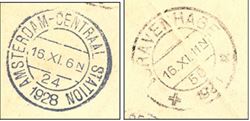
At the post office in The Hague, an extra postmark was applied in red-violet ink to indicate that the postal item had been transported by airmail. Such a postmark is called a propeller stamp, because of the image of an airplane propeller with the back of a letter in the middle. The date in the stamp could be changed. The stamp was designed by André van der Vossen.
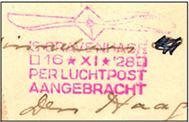
In addition to the post office in The Hague Prinsestraat, the post offices at Amsterdam Central Station and Rotterdam Coolsingel had also received such a propeller stamp.

However, these cancels were not used for long because they had already been taken out of use by mid-February 1930. It was more of an advertising postmark than a postmark with a specific purpose: to indicate that the mail item had indeed been transported by plane. Far more mail items had been offered in the Dutch East Indies than the number that could be transported on this flight, because the maximum permitted weight was 305 kilograms. The mail items that could no longer be carried, a total weight of 252 kilograms, were transported with the steamship "Patria" of the Rotterdamsche Lloyd to Marseille, and from there on to the Netherlands. The overpaid air duty as a result was refunded to the senders by the Indies Postal Service. For this the addressees had to hand over the envelope or postcard as proof!
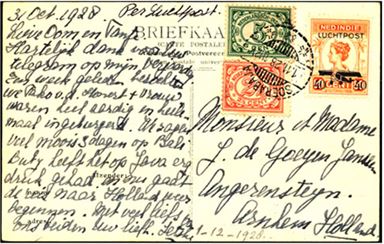
The postcard, correctly franked with 7½ cents and with an airmail stamp of 40 cents, has no imprint of an arrival stamp nor an imprint of the stamp 'applied' and was probably transported by ship to Marseille. The date of arrival is stated in pencil: December 1, 1928. But the card has not been handed in, I wouldn't do it either…… Would you?
August 13th 2015, Cees Janssen
After reading the article I got a feeling of unease. Would I have bought a pig in a poke after all?
First I contacted the author. I already know him for several years as a jury member, albeit for traditional collections, who could help me in this. He confirmed my assumption that my letter is also a so-called "artifical work" letter that should not really be included in an exhibition collection.
But to me it's about the printer's mark and not whether the rate is correct. Would I still be able to use it with an additional text under the letter?
Maximum cards, cards with an image and with a postmark and a stamp on that image, must have maximum coherence, on the understanding that the image on the card may not be the same as the image on the stamp. In short, the card image may not be an enlargement of the stamp.
But I do have such an item in my collection, because the "incorrect" card shows the motorcycle better than the postage stamp itself. Never commented on it. Not even when I explicitly asked about it.
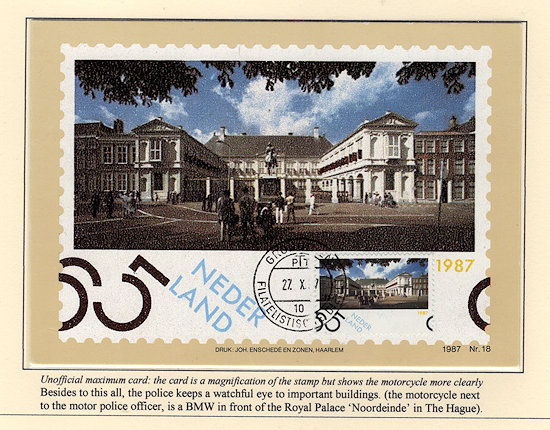

My plan is to show both the Dutch East Indies letter with printer's mark and the loose Dutch stamp in Chapter 1, around 1922, with the thematic text that the motorcycle was so popular at that time that a printer at Firma Enschedé chose this as his printer's mark. A philatelic text with a comment about overfranking, the entire series of airmail stamps for a collector in the Netherlands, and a reference to the special printer's mark on airmail stamps of 10 cents must justify the presence of the letter in the collection.
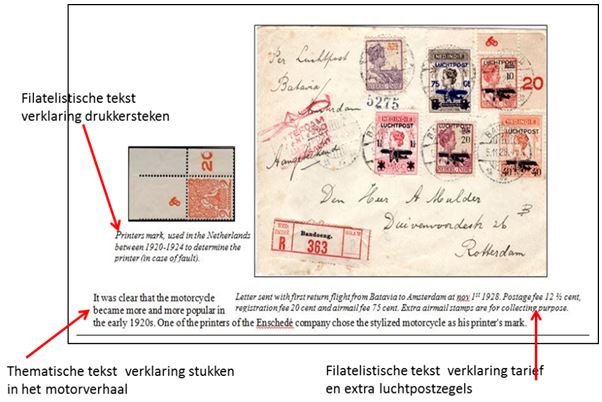
So in the end this doesn't have to be a pig in a poke, but it is a special asset to the (exhibition) collection.
Nico Helling
PS: for those who want to know more about all kinds of philatelic curiosities, I refer with pleasure to: www.postzegelblog.nl where many interesting articles (in Dutch) can be found.
Top - Back to former page - Home |












 The letter was sent from Tjibadak on November 2nd 1928 to The Hague. The postage and registration fee, 12½ cents plus 20 cents, was paid with the 32½ cent postage stamp. The 75 cent airmail stamp would have been sufficient, but the sender opted for a complete set. The letter was sent along with the so-called first return flight that departed on November 6th 1928 from Bandoeng to Batavia, and from there on November 7th 1928 to Amsterdam.
The letter was sent from Tjibadak on November 2nd 1928 to The Hague. The postage and registration fee, 12½ cents plus 20 cents, was paid with the 32½ cent postage stamp. The 75 cent airmail stamp would have been sufficient, but the sender opted for a complete set. The letter was sent along with the so-called first return flight that departed on November 6th 1928 from Bandoeng to Batavia, and from there on November 7th 1928 to Amsterdam.




